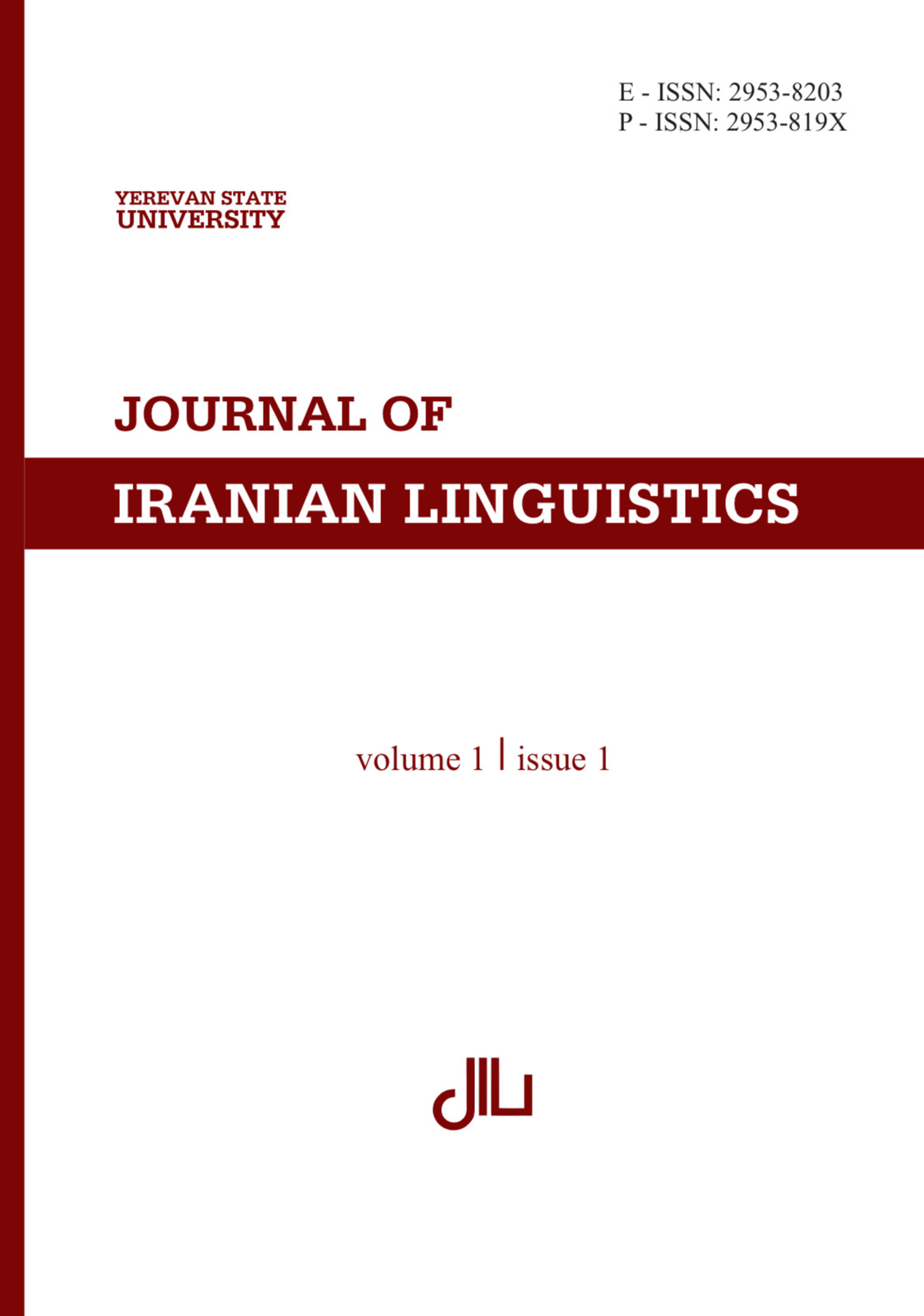Mirativity in Persian
DOI:
https://doi.org/10.46991/jil/2024.01.07Keywords:
mirativity, evidentiality, perfect verb, focus, grammaticalizationAbstract
Mirativity, as a distinct grammatical category, could be marked by different markers and strategies. In this paper, it is argued that, contrary to previous studies, Persian marks mirativity by using morphosyntactic forms. Three different grammatical tools are identified. First, it has a sentence final clitic ‘=ā’ used as mirative marker on its own right. It indicates that the information is newsworthy, unexpected and surprising. Second, the sentence final particle 'ke', among its different functions, marks mirativity, as well. Third, using different perfect verb forms in Persian is a mirative strategy, which is strongly connected to indirect evidentiality. The data from Persian widens our understanding of mirativity cross-linguistically, showing that a language could have different ways to mark it simultaneously.
References
Aikhenvald, Alexandra Y. 2012. The essence of mirativity. Linguistic Typology, 16(3), 435-485. https://doi.org/10.1515/lity-2012-0017
Anonby, Erik and Morteza Taheri-Ardali. 2018. Bakhtiari. Haig, Geoffrey and Geoffrey Khan (eds.). The languages and linguistics of Western Asia; an areal perspective. 445-480. Berlin/Boston: De Gruyter Mouton.
Bubenik, Vit and Ziamajidi, Leila. 2020. The rise of the analytic perfect aspect in West Iranian languages. In Drinka, Bridget (ed.) Historical Linguistics 2017. Selected papers from the 23rd International Conference on Historical Linguistics, San Antonio, Texas, 31 July – 4 August 2017. 273-292. John Benjamins Publishing Company. https://doi.org/10.1075/cilt.350.13bub
Bulut, Christiane. 2018. The Turkic varieties of Iran. Haig, Geoffrey and Geoffrey Khan (eds.). The languages and linguistics of Western Asia; an areal perspective. 398-444. Berlin/Boston: De Gruyter Mouton.
Comrie, Bernard. 2000. Evidentials: semantics and history. In Lars Johanson & Bo Utas (eds.). Evidentials: Turkic, Iranian and Neighbouring Languages. 1-12. Berlin/ New York: Mouton de Gruyter.
de Haan, Ferdinand. 2012. Evidentiality and Mirativity. Oxford Handbooks Online. https://doi.org/10.1093/OXFORDHB/9780195381979.013.0036
Delancey, Scott. 1997. Mirativity: The grammatical marking of unexpected information. Linguistic Typology, 1(1), 33-52.
Delancey, Scott. 2012. Still mirative after all these years. Linguistic Typology, 16(3), 529-564. https://doi.org/10.1515/lity-2012-0020
Fang, Hongmei. 2018. Mirativity in Mandarin: the sentence-final particle Le (了). Open Linguistics 4: 589-607. https://doi.org/10.1515/opli-2018-0029
Haig, Geoffrey and Khan, Geoffrey. (eds.). 2018. The languages and linguistics of Western Asia; an areal perspective. Berlin/Boston: De Gruyter Mouton.
Haig, Geoffrey and Rasekh-Mahand, Mohammad. 2022. HamBam: The Hamedan-Bamberg Corpus of Contemporary Spoken Persian. Bamberg: University of Bamberg. (multicast.aspra.uni-bamberg.de/resources/hambam/) (date accessed)
Hengeveld, Kees and Olbertz, Hella. 2012. Didn't you know? Mirativity does exist!" Linguistic Typology. 16 (3). 487-503. https://doi.org/10.1515/lity-2012-0018
Jahani, Carina. 2000. Expressions of indirectivity in spoken modern Persian. In Lars Johanson & Bo Utas (eds.). Evidentials: Turkic, Iranian and Neighbouring Languages. 185-207. Berlin/ New York: Mouton de Gruyter.
Lars, Johanson. 1998. Code-copying in Irano-Turkic. Language Sciences 20(3): 325-337.
Lazard, Gilbert. 1957. Grammaire du persan contemporain. Translated into Persian by Mahasti Bahreini (2018), Tehran: Hermes Publications.
Johanson, Lars & Utas, Bo. (eds.). 2000. Evidentials: Turkic, Iranian and Neighbouring Languages. Berlin/ New York: Mouton de Gruyter.
Jügel, Thomas. 2020. The perfect in Middle and New Iranian languages. In Crellin, Robert and Jügel, Thomas (eds.), Perfects in Indo-European languages and beyond. 279-310. John Benjamins Publishing Company.
Kiral, Filiz. 2000. Reflections on -miš in Khalaj. In Lars Johanson & Bo Utas (Eds.). Evidentials: Turkic, Iranian and Neighbouring Languages. 89-101. Berlin/ New York: Mouton de Gruyter.
Lazard, Gilbert. 1999. Mirativity, evidentiality, mediativity, or other? Linguistic Typology 3: 91–110.
Lazard, Gilbert. 2001. On the grammaticalization of evidentiality. Journal of Pragmatics 33. 358– 368.
Lee, Sooman, N. 1996. A grammar of Iranian Azarbaijani. Ph.D. dissertation. Linguistics COGS, University of Sussex.
Meshkinfam, Mehrdad. 2020. The grammaticalization of indefinite article in Persian; a Construction Grammar approach. Ph.D. dissertation. Bu-Ali Sina University, Hamedan, Iran.
Mofidi, Roohollah and Petré, Peter. 2022. Aspectual marking from a typologically uncommon origin: a quantitative account of the development of hamē(w) in Middle Persian. Folia Linguistica, 56: 97-127. https://doi.org/10.1515/flin-2022-2025
Oroji , Mohammad Reza & Rezaei, Amir. 2013. Exploring ‘ke’ as a Focus Particle
in Persian from both Form and Function Points of View. Australian Journal of Linguistics, 33:1, 76-84
Peterson, Tyler. 2017. Problematizing mirativity. Review of Cognitive Linguistics 15:2. 312-342.
Perry, John. R. 2000. Epistemic verb forms of Iran, Afghanistan and Tajikistan. In Lars Johanson & Bo Utas (Eds.). Evidentials: Turkic, Iranian and Neighbouring Languages. 229-258. Berlin/ New York: Mouton de Gruyter.
Slobin, Dan & Aksu, Ayhan. 1982. Tense, aspect, and modality in the use of the Turkish evidential. In Paul Hopper (ed.), Tense-Aspect: Between Semantics and Pragmatics, 185-200. Amsterdam: Benjamins.
Tavangar, Manoochehr and Amouzadeh, Mohammad. 2009. Subjective modality and tense in Persian. Language Sciences 31: 853-873.
Utas, Bo. (2000). Traces of evidentiality in Classical New Persian. In Lars Johanson & Bo Utas (Eds.). Evidentials: Turkic, Iranian and Neighbouring Languages. 259-274. Berlin/ New York: Mouton de Gruyter.
Van der Wal Anonby, Christina. 2018. Kumzari. Haig, Geoffrey and Geoffrey Khan (eds.). The languages and linguistics of Western Asia; an areal perspective. 625-658. Berlin/Boston: De Gruyter Mouton.
Windfuhr, Gemot. (1987). Persian. In Comrie, Bernard. (ed.), The world's major languages. 523-546. London: Routledge.
Downloads
Published
How to Cite
Issue
Section
License
Copyright (c) 2024 Mohammad Rasekh-Mahand

This work is licensed under a Creative Commons Attribution-NonCommercial 4.0 International License.


